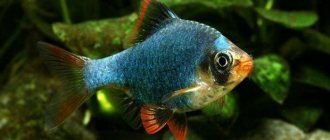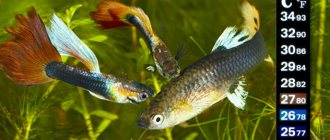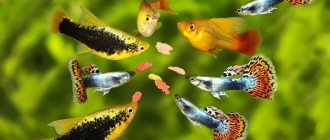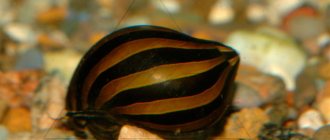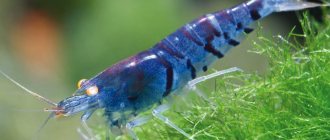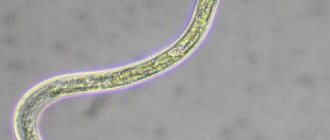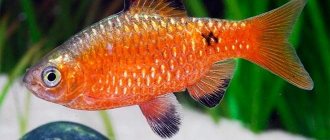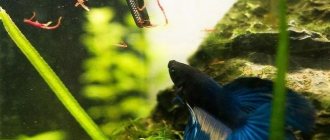We will tell you how to treat fish for semolina at home in this article. The disease is very serious. It threatens pets with death, so it is imperative to get rid of the disease. However, the treatment is not the easiest. If you notice that your pets in the aquarium have begun to become covered with small white spots, our article is for you. What kind of disease is semolina and how to fight it - read on.
Causes and initial signs of the disease
Semolina (scientifically ichthyophthyriosis) is a disease of an infectious nature. In the first days, 1-2 white spots appear on the pet’s body, but every day there are more of them. Because of these spots, the disease is popularly called semolina.
Semolina appears in fish due to a parasite. The disease is caused by the ciliate ichthyophthirius. Penetrating into the pet’s body, it grows quickly and penetrates under its skin, forming white tubercles on the body that look like spots of semolina. However, the behavior of the infected fish does not change. Occasionally she itches on rocks, plants and soil. If the ciliates have affected the internal organs of the fish, then the pets almost do not react to stimuli from the outside. They refuse food, constantly rise to the surface of the water and grab air.
If the ciliate penetrates the eyeball, the pet goes blind.
Symptoms
You can notice that the fish in the aquarium are sick with semolina with the naked eye. A large number of dermoid nodules, small grains of light gray, light yellow color with a diameter of about 0.5–1 mm, appear on the body of the fish (in the mouth, on the gills, fins, abdomen). It seems that the fish is completely covered with semolina. This is especially noticeable in fish with dark scales.
At the onset of the disease, the behavior of the fish practically does not change. The fish swim actively and eat food well. At the same time, sick pets, due to severe itching, rub against various objects, swim jerkily or rush around the aquarium, and behave more restlessly. When the fish are severely affected, the skin is severely affected, the body is covered with large light yellow spots.
Severe form of the disease
Ichthyophthiriasis reduces the immunity of sick fish. Aquarium inhabitants become vulnerable to parasites, bacteria, and viruses. Therefore, secondary infections may develop against the background of this fish disease.
Ichthyophthyriosis is characterized by an aggressive course and rapid development. Under favorable conditions, parasites multiply quickly. The number of infected fish in the aquarium increases day by day. Fry, small fish, heavily covered with white coating, if treatment is not started, die within 2-3 days.
As the disease progresses, the body of the fish is almost completely covered with light grains. The fish begin to swim frantically, twitch their fins, or, on the contrary, hang for a long time in the upper layers of the reservoir, greedily swallowing air. Infected fish stop taking food and do not respond to external stimuli.
In acute cases, the gill filaments and fins are primarily affected. The fish are itching against the algae and decor, trying to free themselves from parasites, and rushing chaotically around the aquarium. With severe damage, the fins split and look frayed. In addition to white grains, bleeding wounds and ulcers appear on the body. Pathological overlays provoke necrosis of the fins.
Disease progression and potential casualties
After 3-5 days, the size of the ciliate is 1 mm. After it has reached the desired size, it leaves the body and sinks to the bottom of the aquarium. There the parasite lays cysts. They share 6-8 hours. After just 2 days, new ciliates are looking for their next victim.
It is easy to determine that a pet is sick with a careful examination. First, pay attention to the color: a fish infected with ciliates becomes much paler than others. Later, you will notice subtle white spots.
Remember that if the ciliate affects a large area of the skin epithelium or the eyes of the fish, the pet may die.
A disease such as ichthyophthyriosis can appear in any fish. Most often, viviparous individuals suffer from this disease. The disease manifests itself in spring and summer. It is then that ciliates actively reproduce, their numbers in water bodies increase greatly, and it is easier for them to penetrate into the home aquarium.
Ichthyophthyriosis: symptoms and diagnosis
Pets suffer from semolina for about 2 weeks. If left untreated, all inhabitants die. The fry die on the 8th day. Livebearers and girardinuses are the least likely to suffer from ichthyophthyriosis.
As soon as the ciliates have entered the gill covers and the upper layer of the epithelium, the following symptoms appear in the fish:
- Anxiety.
- Pets begin to rub against plants and algae.
- They try to swim in the area of bubbles coming from aeration.
- When trophonts form, white tubercles become noticeable on the body of the fish.
- The pet often rises to the surface and swallows air.
At the last stage of semolina, the inhabitants of the aquarium do not react to external stimuli and refuse to eat. Sometimes during illness the corneas of the eyes are affected, which leads to blindness. When ichthyophthirius multifiliis leaves the body of an aquarium inhabitant, it breaks the capillaries. Because of this, blood clots appear on the body, gas exchange in the fish’s body is disrupted, the body is poisoned by the waste products of the parasites, and the pet’s death soon occurs.
Why does the disease appear?
Semolina in aquarium fish occurs for various reasons:
- unsanitary conditions;
- cold;
- infection from outside;
- stress.
We recommend reading
Treatment of fin rot
The first is severe soil contamination. The aquarium needs to be washed and cleaned, plaque must be removed from the walls, the soil must be siphoned off, and the filters must be thoroughly rinsed. But you shouldn't do this too often. From living in too clean an environment, fish's immunity decreases.
You can buy a sick pet in a store, and it will infect others. Before buying fish, inspect them: there should be no mucus, tubercles, or damage on their body. Be sure to quarantine the fish for 2-4 weeks before introducing a new fish into the aquarium. To do this you will need a 3 liter jar. There is no need to put soil in it, but a few artificial plants won't hurt.
Cold water also provokes illness. It is necessary to maintain normal water temperature in the aquarium.
Another reason is the penetration of feed, water, plants and interior items infected with the parasite into the water. Before placing any objects into the aquarium, they should be disinfected.
The development of severe stress in fish is fraught with disease. It usually occurs in pets when moving or cleaning the aquarium.
Let's start getting rid of semolina
Previously, many aquarists believed that ichthyophthyriasis was very easy to get rid of. Nowadays, most of the parasites that cause it have adapted to medications, so it has become very difficult to treat the disease.
The sooner you identify the disease and treat it, the fewer aquarium fish will suffer. Remember: semolina is very dangerous for any fish; your pet can die from it within 7-9 days from the appearance of the first signs of the disease.
We start getting rid of the scourge by raising the temperature. Ciliates that have entered the aquarium are able to live at 25-27 degrees. Therefore, if you make the water warmer, they will die.
At a water temperature of +34 degrees, ciliates die in 4-6 hours, but when increasing the temperature, carefully monitor how your pets react to this. If their health worsens, they are lethargic, then remove them from the water.
How to treat semolina in fish
Before you begin treating semolina in fish, you should understand some of the characteristics of the parasite. In the body of the fish, the ciliate hides under the upper layer of the epithelium. Medicines can only overcome parasites that have escaped into the external environment. In no case should you exceed the dose of the drug, as this may negatively affect the condition of the fish. Equal ciliates react poorly to increases in water temperature. The first signs of semolina appear a few days after the parasite has entered the victim’s body.
Salt helps with any ailment
There is a radical, but proven way to get rid of semolina using salt. Salt is a very effective drug, but the main thing is to keep all the proportions correctly.
You need to add salt to your aquarium, calculating one tablespoon for every 10 liters of water. Raise the temperature to 30-32 degrees and set the aeration to full power around the clock. After such manipulations, there will be less oxygen in the water, and high temperatures will have a detrimental effect on the ciliates.
The duration of treatment is 2 weeks. Next, change 1/3 of the water from the general aquarium every day for 1 month.
While treatment is ongoing, keep an eye on the fish. Not all of them tolerate water and salt well. If any fish cause concern, stop treatment immediately and clean the aquarium.
Treatment of ichthyophthyriosis
Previously, it was believed that semolina fish disease was easily treatable. But any form of life evolves, ciliates are no exception. And now it is becoming difficult to cure fish from this disease.
Treatment of semolina in fish should be started immediately at the first signs of the disease. An advanced infection will destroy the largest inhabitants in just a few days. It is important to remember that the defeat of one fish leads to the development of pathology in absolutely all inhabitants. Therefore, treating ichthyophthyriasis in a community aquarium is the best option, allowing you to get rid of the parasites entirely.
First you need to remove all equipment and decor from the aquarium. It is best to replace them with new ones. Can be treated with boiling water and soaked in furatsilin. Then develop a treatment method, taking into account the characteristics of all the inhabitants of the aquarium. The fact is that some drugs can cure some fish, but kill other fish.
The first thing to do is raise the temperature of the water. The increase threshold is 32 degrees. This is done to accelerate the development of ciliates and leads to their death. But you need to remember that not all aquarium inhabitants can withstand such temperatures. It is better to place such fish in another container and treat them using other methods.
An increase in temperature causes an immediate response from the fish's immune system, but can be harmful to those pets whose gills are severely damaged. This method must be used with caution so as not to kill the fish.
The chemical and medicinal method involves the use of such means as:
- Using table or sea salt
- Adding the drug “malachite green”,
- Treatment of water with hydrogen peroxide,
- The use of furatsilin,
- Medications.
Salt method
Treatment of semolina with salt is carried out in a common aquarium. The amount of salt depends on the volume of water. The calculation is as follows: 1 tablespoon per 10 liters of water. Preliminary dissolution of the salt is not required; it can be poured directly into the water. In this case, it is necessary to gradually increase the water temperature. The fish will float to the surface of the water. This is normal, since a concentrated salt solution is formed below, which is destructive for the pathogen. The duration of the procedure is 14 days. Then, for a month, the water is changed every week. Substitution volume 30%.
"Malachite green"
Highly toxic product, sanitary conditioner for aquarium water. They work with it wearing gloves. The medicine requires preliminary preparation. The solution is prepared at the rate of 0.09 mg per 1 liter of water. This concentration of the solution does not cause any particular harm. Of course, the inhabitants have a hard time, but they have no choice. Either treatment or death. The only thing that is taken into account is the presence of scaleless fish species. For such pets, the concentration is reduced to 0.06 mg/l. When using “malachite green”, a partial water change is necessary. This is done like this: replacing the water, then adding the drug. Treatment is carried out until the signs of the disease completely disappear and for several more days to consolidate the therapeutic effect.
Hydrogen peroxide
To treat semolina in a general aquarium with hydrogen peroxide, take a 3% solution. You need to add it carefully, as there is a risk of burning the fins. No more than 1 ml per 10 liters of water. Peroxide works like an oxygen mask. It becomes easier for “patients” to breathe, as peroxide enriches the water with oxygen.
Furacilin
An absolutely safe method of treating semolina with furatsilin will help you quickly get rid of the problem. To prepare the solution, take 1 tablet per 30–40 liters of water. Furacilin infusions are given every other day, replacing 30% of the volume of water.
Medicines
An ichthyologist will advise you on how to treat fish for semolina with medications. In the absence of one, they contact a veterinarian at the nearest clinic. If difficulties arise here, purchase the following medications:
- Antipar,
- Furazolidone,
- Delagil,
- Bicillin – 5,
- Contractal,
- Omnisan,
- Kostapur,
- Ektopur,
- Mikopur.
Antibiotics for treatment
Most often, semolina in fish is treated with antibiotics of the penicillin group. For example, bicillin-5. The drug is used as follows: take 1/3 of the bottle and dilute it in 10 liters of water. The fish are placed in the resulting composition for half an hour. Such dives are done every day for 1 week. For an aquarium, the product is diluted almost the same way: 1/3 of a bottle per 100 liters. This treatment is also carried out for 1 week. There is only one “but”: the antibiotic helps get rid of the secondary bacterial infection, but it will not be able to cure the semolina itself and help sick fish.
We recommend reading
Pregnancy in aquarium fish using the example of swordtails and bettas
You can use furatsilin. This antimicrobial drug is sold at any pharmacy. Take 1 tablet of 0.02 grams and dilute it in 30-40 liters of water. To make the tablet dissolve better, leave it in water for 15 minutes. 1 day after adding the drug, change 20% of the water and add half the dose of the drug. The duration of treatment is 4-6 days.
Detailed instructions for use
To treat adult fish in a general aquarium, a solution is used that contains, in addition to malachite green, copper sulfate.
As for the dosage, 5 ml of the drug is diluted in 10 liters of water and 5 drops of copper sulfate are added there .
You can also separately dilute a mixture of malachite green and copper sulfate in 250 ml of water, mix well and gradually add it to the general aquarium in three doses.
The treatment period for underwater inhabitants varies within one month. The drugs are added to the water every 7-10 days.
Attention : when treating fish, the water temperature in the aquarium rises to 28 degrees Celsius, the activated carbon filter is removed during treatment.
Malachite green is used not only as a treatment for sick fish, but also as a prophylaxis for quarantined aquatic life .
In this case, new fish are placed in a separate container, and the water is treated with the prepared solution for several days.
To prevent diseases, use 5 ml of the drug dissolved in 2 liters of settled water . The water temperature for quarantine fish should be about 22 – 24 degrees Celsius.
The aquarium must have 24/7 water aeration. For quarantined fish, a new and fresh solution is prepared daily.
Sick fish are treated according to the following scheme:
Sick individuals are separated from healthy ones in another separate container installed in a dark place.
During the treatment period, it is not permissible for sunlight to hit the walls of the aquarium, and it is also not recommended to turn on the backlight.- An aeration system is installed in the quarantine tank.
- The medicine is injected into the water 4 times a day, every 5 hours.
- The first two days its concentration is 5 mg per 2 liters of water, then the dosage increases, 5 ml of the drug is diluted in 0.5 liters of water.
- Fish must be in air-conditioned water for at least 5 hours. Then they can be placed in an aquarium with clean water.
- For treatment effectiveness, the solution is diluted fresh each time.
- The water temperature in the quarantine aquarium should be within 28 degrees Celsius.
Attention : treatment of sick fish is carried out in a separate container without vegetation and soil.
The first half hour after adding the drug, you need to monitor their behavior . If the fish begin to behave restlessly, the concentration of the solution will have to be reduced.
We use hydrogen peroxide and anti-steam
A 3% solution of hydrogen peroxide will also help get rid of semolina from fish. It is diluted as follows: pour 1 ml of product into 10 liters of water. This treatment is carried out 2 times a day. Thanks to peroxide, the aquarium will be saturated with oxygen and will improve the breathing of the fish, but the dose cannot be exceeded, otherwise the pets will get burned.
A product called Antipar also helps get rid of semolina from aquarium fish. This liquid solution has antibacterial, antiparasitic, and antifungal effects. This product contains malachite green and formaldehyde. For treatment, 1 ml of the product is used, and it is diluted in 10 liters of water.
The fish is immersed in the resulting composition for 3 hours. The procedure is carried out 2 times a day. Then a break for a day, and repeat again. For prevention, the procedure is done once. The medicine can be added to the general aquarium. To do this, take 1 ml of product per 50 liters. The duration of treatment is 5-7 days. In this case, the owner needs to change 1/3 of the water daily.
Methods for treating semolina
It is important not only to treat pets, but also to carry out measures aimed at disinfecting the aquarium itself. Previously, it was believed that the disease of aquarium fish, semolina, could be cured very easily. Nowadays, it has become more difficult to get rid of it, because ciliates have developed immunity to means of combating them.
As soon as the first symptoms are noticed , you need to start treatment , otherwise within a week the inhabitants of the aquarium will begin to die. Therapy can be carried out in two ways. The first is to quarantine infected individuals in a separate container, the second is to carry out treatment in a common aquarium.
You can get rid of whiteheads using salt, peroxide, brilliant green, antibiotics, as well as a mixture of brilliant green with other drugs.
There are a number of home remedies available
Home Remedies
You can treat semolina in fish with malachite green. First, the drug is added to the aquarium at the rate of 0.09 mg per 1 liter of water. After a couple of days, the concentration is reduced to 0.06 mg per 1 liter of water. At the same time, it is worth changing the water in the artificial reservoir by ¼ every day. Treatment lasts until the white spots disappear, and then another 2-3 days to consolidate the result.
Treatment of semolina in aquarium fish with salt is suitable in cases where the bacteria were introduced by local water. For two weeks, use 10 grams of salt per 10 liters of water. During treatment, it is necessary to increase the temperature in the aquarium to 32 degrees. At the end of therapy, once a week you need to change the water by 1/3 for a month. Ciliates die due to the fact that the oxygen necessary for their life becomes less. And high temperatures prevent reproduction.
You can also treat semolina in aquarium fish with hydrogen peroxide. To do this, add a 30% solution of the drug to water at the rate of 1 ml per 10 liters. It is important not to increase the concentration, otherwise this may cause fin burns.
You can treat semolina with hydrogen peroxide
Other control methods
For ichthyophthyridiasis, you can make a mixture of malachite green with other medicines. Antipar, Furacilin and Nitrofuran are used. Antipar is a universal drug based on formaldehyde and brilliant green. It is used at the rate of 1 ml per 50 liters of water. The course is 5 days. You can repeat it in a week. Some pets may die because the drug is intolerable to them. But sometimes it is worth sacrificing a small number of aquarium inhabitants in order to remove parasites and save the majority of the fish.
Furacilino is a water-soluble yellow powder. Treatment is carried out with a solution prepared from 0.1 grams of the drug and 50 liters of water for two weeks. After each procedure, the water in the aquarium must be changed.
Semolina responds well to treatment with branded drugs from the pharmacy. Among them it is worth highlighting Aquarium Pharmaceuticals, Tetra, Serra. Before using them, you should carefully study the instructions.
To avoid mass infection, you need to pay close attention to the behavior of your pets and adhere to safety measures. You should also quarantine new fish and monitor the cleanliness of the aquarium.
Therapy with furatsilin and furazolidone
In addition to preparations that contain malachite green, nitrofuran agents are added. They help get rid of semolina from fish and also have an antiparasitic effect. A product commonly used is called "Super Ick Cure".
Products containing malachite green can be combined with furatsilin. Take 1.5 tablets of the drug and dilute it in 20 liters of water, then add malachite green in the dosage specified by the manufacturer. Furacilin can be used in another way: take 6-8 tablets and dilute in 100 liters of water.
Furazolidone is a domestic antibiotic. For treatment, 1 tablet is used, which is diluted in 10 liters. The drug has an antimicrobial effect and helps get rid of concomitant infections.
Use of imported drugs
Treatment of semolina is successfully carried out with the drug Sera Costapur. It is economical: a 50 ml package is enough for 800 liters of water. It does not have a negative effect on fish. The composition includes malachite green, formaldehyde, distilled water. When using semolina, the composition is diluted as follows: take 1 ml of the product and dilute it in 40 liters of water. After three days, the composition is poured again. At the same time, the filter and aeration system in the aquarium is turned off.
We recommend reading
Why can fish die in an aquarium?
The second imported product used to treat semolina is Tetra Contralck plus. The drug is effective against semolina and does not disturb the natural balance in the aquarium. Sera Mycopur is also used. Although it is considered antifungal, the copper compounds in its composition act on ciliates.
How to treat a disease with iodine and potassium permanganate
Iodine is sometimes used to treat semolina. Dilute 2 drops of iodine in 10 liters of water. Be sure to combine iodine treatment with the use of drugs such as furatsilin, antipar.
You can try to get rid of the disease using potassium permanganate, although it does not always help, and in general this is a controversial method. The drug is diluted as follows: take 5 grams of manganese crystals and dilute them in 10 liters of water. The composition is mixed in a separate container, then added to the aquarium. The procedure is carried out every 12 hours. Potassium permanganate perfectly disinfects the aquarium, algae and soil.
During treatment with potassium permanganate, carefully monitor the health of the fish; the drug has a negative effect on their health.
What affects the effectiveness of treatment
The effectiveness of treatment for semolina in fish depends on how quickly the owner began treatment. As a rule, it is very difficult to save the first sick fish. Sometimes this fails. But other pets can be quickly cured of this unpleasant disease.
Remember that fish that have been ill with semolina receive immunity from it for 6 months. Also, completely cleaning the aquarium will help reduce the risk of recurrence of the disease.
If an illness is detected, the sick fish must be removed and the filtration in the general aquarium must be turned on at full power. This will reduce the risk of the disease developing in other fish and will help remove new ciliate eggs, which will reduce the likelihood of a repeat outbreak.
Prevention of semolina in fish
To disinfect the aquarium, the inhabitants are transplanted into another container for 8-14 days. And where there was an outbreak of semolina, they raise the temperature to 29-30 degrees. If special preparations were used to treat semolina in fish, then the water is purified with a carbon filter.
To prevent the disease from starting again, some precautions should be taken. All new inhabitants and plants must undergo quarantine. The fact is that a newly acquired fish may already be infected, but the symptoms of the disease are not yet noticeable. After placing it in a community aquarium, semolina can begin to develop very quickly.
New fish should sit in a quarantine tank for 10-14 days. If nothing happened to the new pet during this time, then it can be placed in a common tank.
What to do with an aquarium with semolina
First, catch all the fish from it. The container should be set aside for 3-4 days. At the same time, raise the water temperature to 29-32 degrees. After completing the treatment, filter the liquid using charcoal. This will help get rid of the medications you used while treating your pets. There is no need to remove snails and plants from the container.
Thus, any fish, even an experienced aquarist, can contract ichthyophthyriasis. But even if the fish have semolina, you shouldn’t panic right away. Start treatment using any of the described methods, alternate them if some measure does not help in a particular case.
